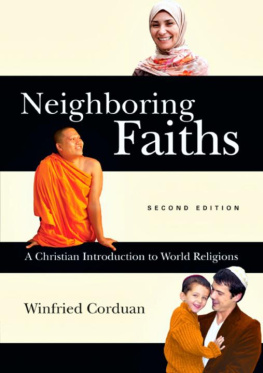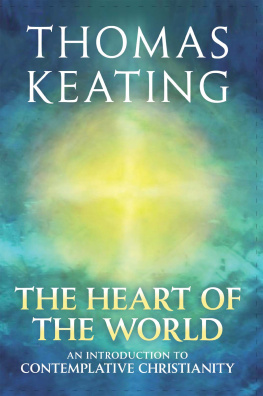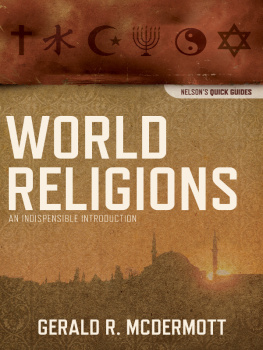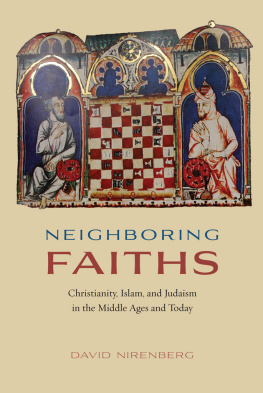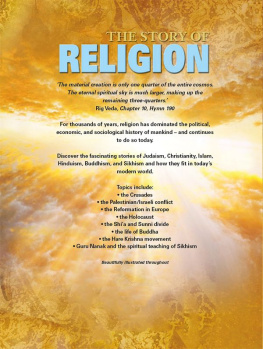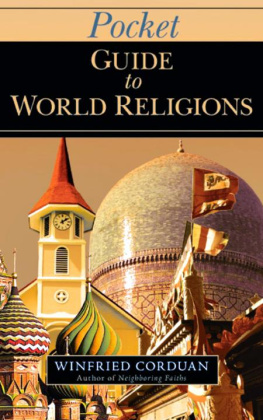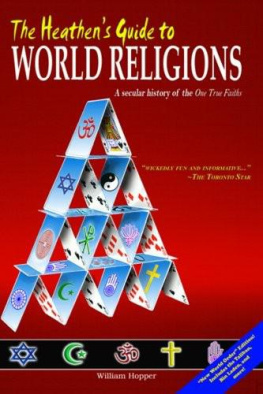Winfried Corduan - Neighboring Faiths: A Christian Introduction to World Religions
Here you can read online Winfried Corduan - Neighboring Faiths: A Christian Introduction to World Religions full text of the book (entire story) in english for free. Download pdf and epub, get meaning, cover and reviews about this ebook. year: 2013, genre: Religion. Description of the work, (preface) as well as reviews are available. Best literature library LitArk.com created for fans of good reading and offers a wide selection of genres:
Romance novel
Science fiction
Adventure
Detective
Science
History
Home and family
Prose
Art
Politics
Computer
Non-fiction
Religion
Business
Children
Humor
Choose a favorite category and find really read worthwhile books. Enjoy immersion in the world of imagination, feel the emotions of the characters or learn something new for yourself, make an fascinating discovery.
- Book:Neighboring Faiths: A Christian Introduction to World Religions
- Author:
- Genre:
- Year:2013
- Rating:5 / 5
- Favourites:Add to favourites
- Your mark:
- 100
- 1
- 2
- 3
- 4
- 5
Neighboring Faiths: A Christian Introduction to World Religions: summary, description and annotation
We offer to read an annotation, description, summary or preface (depends on what the author of the book "Neighboring Faiths: A Christian Introduction to World Religions" wrote himself). If you haven't found the necessary information about the book — write in the comments, we will try to find it.
Neighboring Faiths: A Christian Introduction to World Religions — read online for free the complete book (whole text) full work
Below is the text of the book, divided by pages. System saving the place of the last page read, allows you to conveniently read the book "Neighboring Faiths: A Christian Introduction to World Religions" online for free, without having to search again every time where you left off. Put a bookmark, and you can go to the page where you finished reading at any time.
Font size:
Interval:
Bookmark:



Winfried Corduan

FIGURES
1.1. Religions and their percentages
1.2. Stages in the evolution of religion
1.3. Geographical layout of two hypothetical cultures.
1.4. Decay of religions
1.5. The complexities of contextualization.
2.1. Outline of the first temple
2.2. Composition of the Talmud
2.3. A page out of the Talmud
2.4. Orthodox appearance
2.5. Tzitzit
3.1. Ismailite developments.
3.2. Six beliefs and five pillars
3.3. One rakat of prayer
4.1. Osama bin Laden
4.2. Muhammad ibn Abd al-Wahhab
4.3. Sayyid Qutb
4.4. King Abdullah of Saudi Arabia
4.5. Yasser Arafat.
5.1. Early Baha'i leadership
5.2. Nine great manifestations
5.3. Covenant breakers in Baha'ullah's family
6.1. Components of the Avesta.
6.2. Fravashi spirit
6.3. Zoroastrian time
6.4. Christian time
7.1. Person and spirits
7.2. Healer and shaman
8.1. Tlingit matrilinealism
9.1. Main Hindu Bhakti deities
9.2. Hindu temple roofs
10.1. Four noble truths
10.2. Development of Buddhism
10.3. The noble eightfold path.
10.4. The transcendental Buddhas
11.1. Jain pot.
11.2. Jainism cycle of time
12.1. Ekankar
12.2. Marks of a Singh.
13.1. Some trigrams .
13.2. Development of Daoism
14.1. Shrine complex
14.2. Shinto shrine layout
14.3 Shrine of Ise .
MAPS
2.1. Areas of Jewish flourishing
3.1. The Arabian Peninsula
3.2. Distribution of Shiite Islam
3.3. Expansion of Islam
4.1. Kuwait
5.1. Baha'i origins
6.1. Two Aryan migrations.
6.2. Areas of high Parsi concentration
7.1. Four African tribes
8.1. Regions of Native American people
9.1. Indus Valley civilization
10.1. Theravada countries
10.2. Expansion of Buddhism
11.1. Jain origins.
12.1. Sikh origins
13.1. China
14.1. Japan
TABLES
1.1. Four Variations on a Simple Story
2.1. A Rough Chronology of the Hebrew People
2.2. Estimate of Membership in the Three Branches of Judaism in the United States
2.3. Elements of a Passover Seder
3.1. Brief Overview of the Sunni Succession.
3.2. The First Twelve Imams.
3.3. The Imamite and Ismailite Versions of the First Seven Imams
3.4. The Adhan, Call to Prayer
5.1. Principles of Baha'i in Short.
6.1. Aryan Religions Prior and After Zoroaster
6.2. The Six Amesha Spentas
6.3. Periods in the History of Zoroastrianism
7.1. Variations of Marriage Patterns in Different Cultures
7.2. God in the Four Tribes
7.3. Sequence of Rites of Passage in Four African Tribes
8.1. Brief Summary of Native American Regional Traits
8.2. Tlingit Moieties and Some Representative Phratries
9.1. The Three Ways of Hinduism.
9.2. Some Vedic Deities
9.3. The Four Basic Castes
10.1. The Five, Eight and Ten Precepts
10.2. Mahayana Schools
10.3. Typical Visual Arrangements of Buddhas and Bodhisattvas
10.4. Recently Established Mahayana Buddhist Organizations in Taiwan
11.1. Jain Vows
11.2. Ages of Jainism
11.3. Twenty-Four Tirthankaras of Jainism
11.4. Relationships Among Entities in the World
12.1. Sikh Gurus and the Contemporary Mughal Emperors
12.2. Distinction Between Kabir and Nanak
12.3. Possible Sikh Antecedents
13.1. Major Dynasties of China.
13.2. Yin and Yang.
13.3. Four Chinese Schools of Thought.
13.4. The Eight Immortals
13.5. The Five Relationships
13.6. Years in the Chinese Zodiac.
14.1. Some Japanese New Religions
AN UPDATED EDITION of this book has been overdue for a long time. Unfortunately, for a number of reasons, it has been slow in coming. If there is a positive side to this delay it is this: If I had provided an update ten years ago, a new one would be needed by now as well. Religions are historically unlikely to change. However, we are seeing in our time that, as the world is changing rapidly, religions are picking up the pace of change as well, and the need for us to keep up with their developments continues to grow.
One obvious development in the world of religions is the impact of Islam on the Western world. The events of September 11, 2001, have caused us in the United States to realize how much our lives are intertwined with global developments. In reality, we have been affected by developments around our planet for a long time, but perhaps we are now more aware of this fact than ever before. Specifically there has been an increased curiosity concerning Islam. Unfortunately there has also been a simultaneous increase in the dissemination of misinformation on Islam, both positive and negative. I found that in order to do a fairly adequate job of explaining what lay behind the radical face of Islam, I needed to devote another entire
chapter to it. Thus this new edition has two chapters of Islam, one that covers the basic information on this religion, and one that is particularly devoted to recent events.
The previous edition brought three religions together under the somewhat patronizing title of "off-shoot religions." Doing so had been my decision, but it was a decision that I felt needed to be reversed. This edition has three separate chapters for Jainism, Sikhism and Baha'i. After all, each of these religions makes a special point of the fact that they are the result of unique revelations or insights.
Many of the changes in this new edition are aimed at correcting mistakes, clarifying ambiguities and adding greater precision where needed. I need to thank everyone who, over the years, has pointed out various concerns, real or perceived. I am also grateful for the questions I received from both students and instructors. It was a pleasure to answer them, and I hope that in this edition I have anticipated some of them. It has also been my privilege to share without cost some of my resources, such as my computer slide presentations, with various teachers who have used the book, and I hope to be able to continue to do so. As I've said, it is more urgent than ever that Christians today will become accurately informed on the subject of world religions.
Accuracy is a goal both for its own sake and for the sake of clarifying the distinctiveness and truth of Christianity. However, this book is not an apologetics text per se. It is a survey of world religions, undertaken from a Christian point of view, and it embeds Christian responses. Classroom teachers in world religions know how fast a semester can go by, and it is imperative that we learn the facts of other religions lest we continue building apologetics against other religions based on inaccurate depictions. The Christian who is truly committed to evangelism and apologetics will consider the time it takes to study this subject matter well spent. A Christian apologetic response may not be as glib once one knows what a religion truly teaches, but it will have the advantage of being focused on a reality rather than a straw effigy. Please allow me to mention a few of the widespread misconceptions I hope we can liberate ourselves from:
Font size:
Interval:
Bookmark:
Similar books «Neighboring Faiths: A Christian Introduction to World Religions»
Look at similar books to Neighboring Faiths: A Christian Introduction to World Religions. We have selected literature similar in name and meaning in the hope of providing readers with more options to find new, interesting, not yet read works.
Discussion, reviews of the book Neighboring Faiths: A Christian Introduction to World Religions and just readers' own opinions. Leave your comments, write what you think about the work, its meaning or the main characters. Specify what exactly you liked and what you didn't like, and why you think so.

